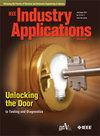为住宅负载实施智能电网功能的单节点方法
IF 4.2
2区 工程技术
Q2 ENGINEERING, ELECTRICAL & ELECTRONIC
引用次数: 0
摘要
本文介绍并测试了一种实现智能电网功能的单节点方法,用于操作住宅负载。所提出的方法基于调整住宅负载的电力需求,以在供电节点实现所需的负载需求曲线。所需的负载需求曲线是根据目标住宅负载中恒温电器(TCA)的运行情况设定的。通过智能电网功能来操作 TCA,从而在每天的非高峰需求时段储存热能。这些储存的热能会在每天的用电高峰时段释放,以减少住宅负载在这些时段的电力需求。分配给每个 TCA 控制器的指令功率(为实现智能电网功能而设置)是使用托管这些 TCA 的住宅负载的修改配置文件启动的。单节点方法在一个拥有 45 栋建筑的大学校园中实施和测试。每栋楼都有中央集中供暖装置和热水器,有些楼还有中央空调装置。测试在不同季节进行,校园建筑的电力需求由峰值需求管理(作为智能电网功能)控制。测试结果表明,为每栋楼分配指令值的单节点方法既准确又简单,可确保减少电力损耗并提高电压。本文章由计算机程序翻译,如有差异,请以英文原文为准。
The One-Node Approach to Implement Smart Grid Functions for Residential Loads
This paper presents and tests a one-node method for implementing smart grid functions to operate residential loads. The proposed method is developed based on adjusting the power demands of residential loads to achieve a desired load-demand profile at the supply node. A desired load-demand profile is set based on operating thermostatically controlled appliances (TCAs) in the target residential loads. Smart grid functions are implemented to operate TCAs so that thermal energy is stored during the daily off-peak-demand hours. This stored thermal energy is discharged during daily peak-demand hours in order to reduce power demands of residential loads during these hours. The command power assigned to each TCA controller (set to implement smart grid functions) is initiated using a modified-profile for residential load hosting these TCAs. The one-node method is implemented and tested for a university campus that has 45 buildings. Each building has central central heating units and water heaters, and some buildings have central air conditioner units. Tests are performed for different seasons, where power demands of campus buildings are controlled by peak-demand management (as a smart grid function). Test results show the accuracy and simplicity of the one-node method to assign command values for each building to ensure reduced power losses and improved voltage.
求助全文
通过发布文献求助,成功后即可免费获取论文全文。
去求助
来源期刊

IEEE Transactions on Industry Applications
工程技术-工程:电子与电气
CiteScore
9.90
自引率
9.10%
发文量
747
审稿时长
3.3 months
期刊介绍:
The scope of the IEEE Transactions on Industry Applications includes all scope items of the IEEE Industry Applications Society, that is, the advancement of the theory and practice of electrical and electronic engineering in the development, design, manufacture, and application of electrical systems, apparatus, devices, and controls to the processes and equipment of industry and commerce; the promotion of safe, reliable, and economic installations; industry leadership in energy conservation and environmental, health, and safety issues; the creation of voluntary engineering standards and recommended practices; and the professional development of its membership.
 求助内容:
求助内容: 应助结果提醒方式:
应助结果提醒方式:


